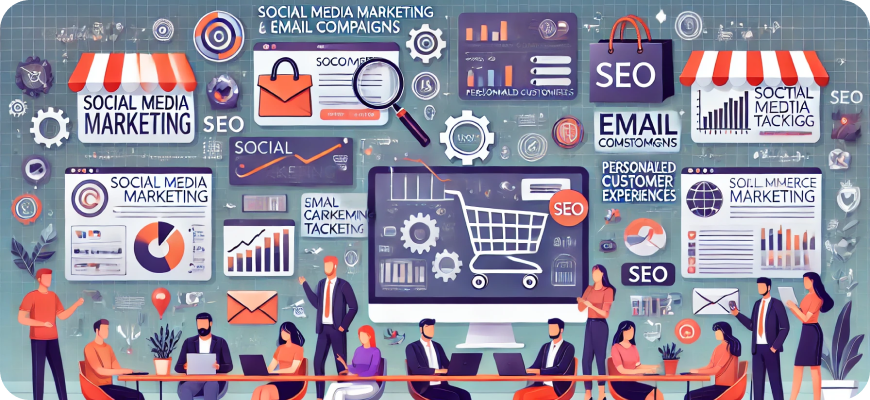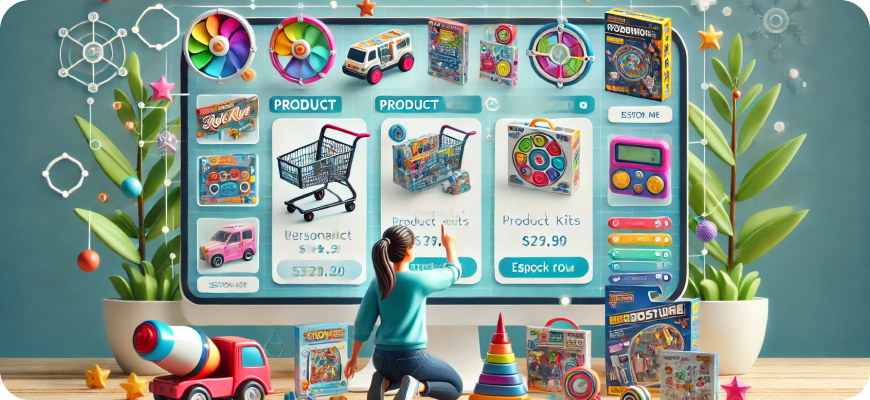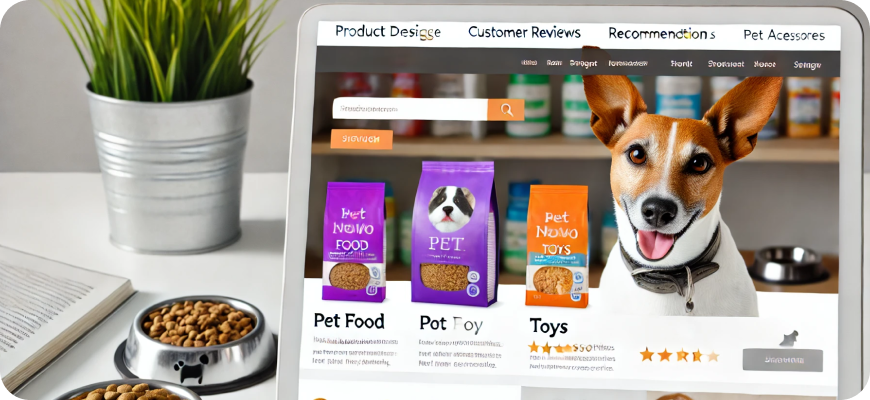Marketing Tactics for Your E-commerce That Boosts Your Sales
The e-commerce landscape has grown increasingly competitive, making it essential for online businesses to adopt effective marketing strategies that not only attract potential customers but also convert them into loyal buyers. To stay ahead, e-commerce entrepreneurs must employ a combination of tried-and-tested tactics as well as innovative approaches tailored to the unique needs of their target audiences. Here’s a comprehensive guide on marketing tactics that can help you boost your e-commerce sales and drive sustainable growth.

1. Optimize Your Website for User Experience (UX)
A well-designed, easy-to-navigate website is the foundation of a successful e-commerce store. Poor user experience can deter customers, leading to high bounce rates and lost sales opportunities.
Key Tips:
- Ensure Mobile Responsiveness: With a significant number of users shopping on their smartphones, a mobile-optimized website is crucial.
- Improve Page Load Speed: Faster loading times reduce bounce rates and improve conversion rates. Use tools like Google PageSpeed Insights to identify and fix issues.
- Simplify Navigation: Make it easy for visitors to find what they’re looking for with clear menus, a search bar, and well-organized product categories.
- Optimize Checkout Process: A complicated checkout process can lead to cart abandonment. Offer guest checkout options, multiple payment methods, and a streamlined process.
2. Leverage Social Media Marketing
Social media platforms like Facebook, Instagram, Pinterest, and TikTok are powerful tools for reaching and engaging with potential customers.
Tactics to Try:
- Create Engaging Content: Share product photos, videos, user-generated content (UGC), tutorials, and behind-the-scenes looks at your brand.
- Use Influencer Marketing: Collaborate with influencers in your niche to promote your products. Influencers can boost brand awareness and credibility.
- Run Paid Social Ads: Utilize Facebook and Instagram ads to reach specific audience segments with personalized offers and promotions. Use retargeting to reach users who have already visited your site but didn’t make a purchase.
- Engage with Your Audience: Respond to comments, messages, and mentions to build a sense of community and trust around your brand.
3. Invest in Search Engine Optimization (SEO)
SEO is a cost-effective way to increase organic traffic to your website. By optimizing your site and content for search engines, you can improve your rankings and visibility.
SEO Strategies for E-commerce:
- Keyword Research: Use tools like Ahrefs, SEMrush, or Google Keyword Planner to identify relevant keywords for your products and categories.
- Optimize Product Pages: Include relevant keywords in product titles, descriptions, image alt texts, and meta tags.
- Create High-Quality Content: Publish blog posts, buying guides, and how-to articles that address the needs and interests of your target audience. Internal linking to product pages can drive traffic and improve SEO.
- Build Backlinks: Establish partnerships with relevant blogs and industry websites to earn backlinks and improve your domain authority.
- Optimize for Voice Search: As voice search becomes more popular, optimize your content with conversational keywords and FAQs.
4. Utilize Email Marketing Campaigns
Email marketing is one of the highest ROI-generating channels for e-commerce businesses. It allows you to nurture leads, build customer relationships, and drive repeat sales.
Effective Email Marketing Tactics:
- Segment Your Audience: Send personalized emails based on user behavior, purchase history, and demographics.
- Abandoned Cart Emails: Send follow-up emails to users who leave items in their cart, offering incentives like discounts or free shipping.
- Welcome Series: Create a sequence of welcome emails for new subscribers to introduce your brand and encourage their first purchase.
- Promotional Campaigns: Use email to announce new product launches, sales, limited-time offers, and seasonal promotions.
- Reactivation Campaigns: Re-engage inactive subscribers with special offers or content tailored to their interests.
5. Offer Discounts, Promotions, and Loyalty Programs
Everyone loves a good deal, and promotional offers can be a powerful motivator for shoppers to complete a purchase.
Examples of Promotions:
- Flash Sales: Create urgency with limited-time offers.
- Discount Codes: Provide coupon codes for first-time buyers, referrals, or during special occasions.
- Free Shipping: Offer free shipping when customers meet a certain spending threshold.
- Loyalty Programs: Reward repeat customers with points they can redeem for discounts, exclusive products, or other perks. This encourages customer retention and brand loyalty.
6. Optimize for Conversion Rate (CRO)
Conversion rate optimization focuses on turning visitors into paying customers by improving your website’s user experience and persuasive elements.
CRO Strategies:
- A/B Testing: Test different versions of landing pages, headlines, call-to-action buttons, and images to see which performs better.
- Use High-Quality Product Images: Offer multiple views of your products, including zoomed-in and 360-degree images, to give customers a clear sense of what they’re buying.
- Add Customer Reviews and Ratings: Social proof can significantly boost trust and encourage conversions.
- Display Trust Badges: Showcase security badges, payment icons, and guarantees to reassure customers during the buying process.
7. Utilize Content Marketing
Content marketing helps establish your brand’s authority, build trust with your audience, and drive organic traffic.
Content Ideas:
- Blog Posts: Publish educational, informative, or entertaining articles relevant to your niche.
- Video Content: Create product demos, tutorials, behind-the-scenes videos, and customer testimonials.
- Buying Guides: Help customers make informed purchase decisions by providing detailed guides on your products.
- Social Proof: Share case studies, testimonials, and user-generated content to build credibility.
8. Implement Retargeting Ads
Not all visitors will make a purchase on their first visit to your website. Retargeting ads allow you to re-engage users who have shown interest but didn’t convert.
Retargeting Tips:
- Dynamic Product Ads: Show users ads featuring the exact products they viewed on your site.
- Cross-Sell and Upsell: Retarget customers with complementary or upgraded products.
- Time-Sensitive Offers: Encourage hesitant shoppers to return with limited-time discounts or special deals.
9. Leverage User-Generated Content (UGC)
User-generated content, such as customer photos, videos, and reviews, can build trust and authenticity around your brand.
UGC Strategies:
- Social Media Campaigns: Encourage customers to share photos of themselves using your products with branded hashtags.
- Customer Testimonials: Showcase real customer reviews and testimonials on your product pages and marketing materials.
- Photo Contests: Run photo or video contests to encourage customers to engage with your brand and share their experiences.
10. Focus on Customer Service
Excellent customer service can set your e-commerce store apart and create loyal customers who advocate for your brand.
Tips for Providing Exceptional Service:
- Live Chat Support: Offer instant support via live chat to answer customer questions and resolve issues in real-time.
- Prompt Responses: Reply to emails, social media inquiries, and support tickets quickly.
- Clear Return and Refund Policies: Make it easy for customers to understand and access return policies.
- Proactive Communication: Keep customers informed about order status, shipping updates, and potential delays.
11. Collaborate with Other Brands
Partnering with complementary brands can help you reach a wider audience and create mutually beneficial campaigns.
Examples of Collaborations:
- Product Bundling: Offer bundles that include products from both brands.
- Joint Giveaways: Host social media or email-based giveaways with partner brands to increase brand visibility.
- Cross-Promotions: Promote each other’s products through email marketing or social media posts.
12. Leverage Data Analytics
Data-driven decision-making is essential for optimizing your marketing efforts and improving your e-commerce store’s performance.
Key Metrics to Track:
- Conversion Rate: Percentage of visitors who make a purchase.
- Customer Lifetime Value (CLV): Average revenue generated from a customer over their lifetime.
- Customer Acquisition Cost (CAC): Cost of acquiring a new customer.
- Average Order Value (AOV): Average value of each purchase.
- Cart Abandonment Rate: Percentage of visitors who add items to their cart but don’t complete the purchase.
Use tools like Google Analytics, Shopify Analytics, and heatmaps to gain insights into user behavior, identify problem areas, and optimize your marketing efforts.
13. Implement Affiliate Marketing
Affiliate marketing allows you to leverage the influence of others to promote your products in exchange for a commission.
How to Get Started:
- Create an Affiliate Program: Use platforms like Refersion, ShareASale, or Shopify’s affiliate tools to set up and manage your program.
- Recruit Affiliates: Partner with bloggers, influencers, and niche experts who align with your brand values.
- Offer Competitive Commissions: Motivate affiliates to promote your products with attractive commission rates.
14. Run Referral Programs
Referral programs incentivize existing customers to refer new customers to your store, driving word-of-mouth sales.
How to Structure Your Program:
- Offer Rewards: Provide discounts, cash, or free products to customers who refer new buyers.
- Track Referrals: Use referral software like ReferralCandy or Smile.io to manage and track program performance.
- Promote the Program: Use email, social media, and in-store banners to encourage participation.
15. Personalize the Shopping Experience
Personalization can significantly boost conversion rates by providing customers with tailored experiences.
Personalization Tactics:
- Product Recommendations: Use AI-powered tools to suggest products based on browsing and purchase history.
- Dynamic Content: Personalize website banners, emails, and offers based on user behavior and preferences.
- Targeted Emails: Send personalized emails with product suggestions, birthday offers, and cart reminders.

Conclusion
E-commerce success hinges on implementing effective marketing strategies that resonate with your target audience. By optimizing user experience, leveraging social media, focusing on content marketing, and offering personalized experiences, you can boost sales and create a loyal customer base. Remember to continuously analyze performance metrics and adapt your tactics based on data insights to stay ahead in the competitive e-commerce landscape. With the right mix of innovation, creativity, and data-driven approaches, your e-commerce store can thrive and achieve long-term success.






